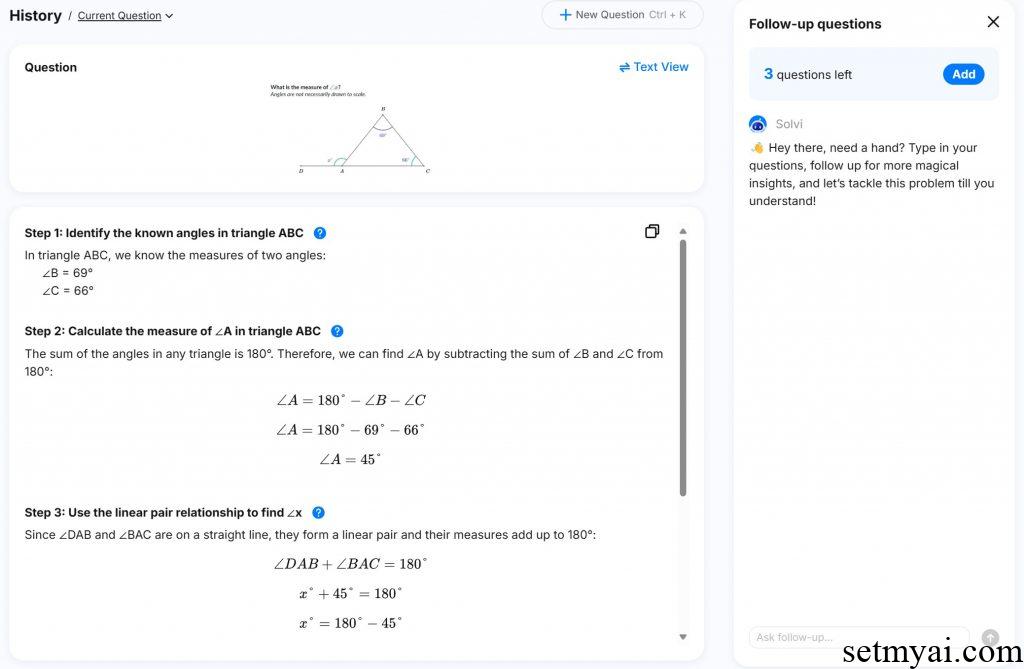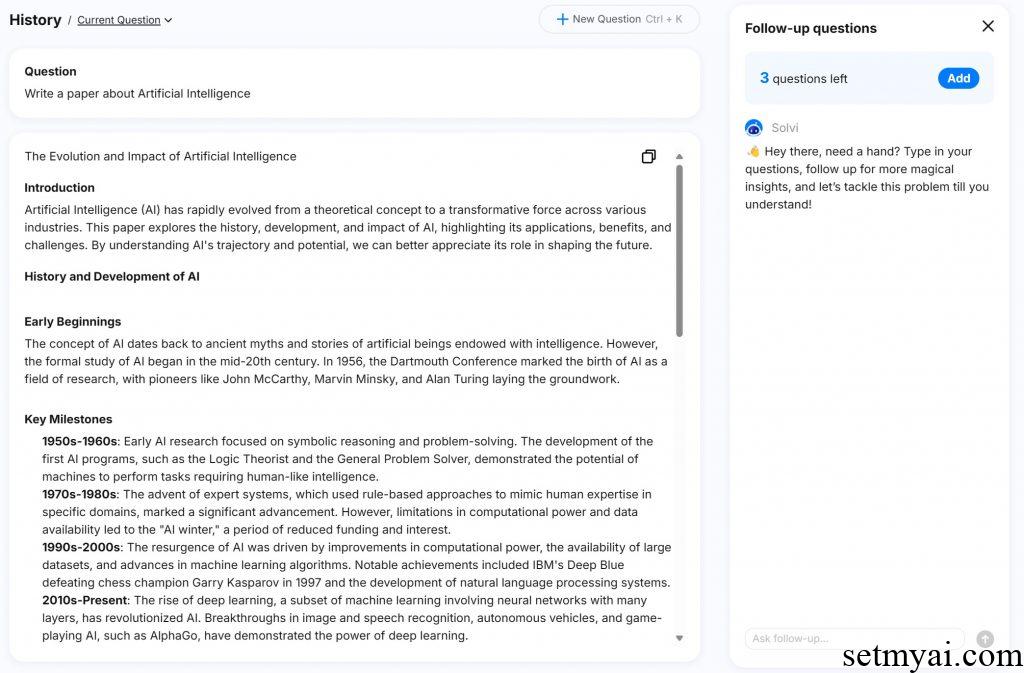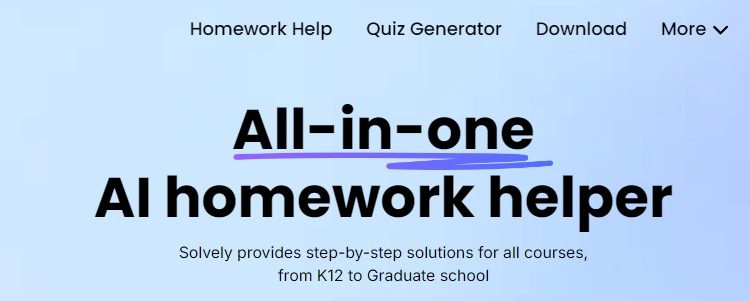Introduction to Solvely AI
Solvely AI is a free homework tutoring tool that users can use to obtain accurate homework answers.
Solvely AI can be used for free, users only need to visit the link below. Solvely AI’s accuracy can surpass many large AI models, and it can provide detailed answer steps and AI question answering functions.
Related Post: Homeworkify Free AI Homework Tutoring Tool
How to Use Solvely AI
We use Solvely AI to test their scores in both mathematics and Chinese. Firstly, let’s upload a math problem, and Solvely AI provides the following solution:
Step 1: Identify the known angles in triangle ABC
In triangle ABC, we know the measures of two angles:
∠B = 69°
∠C = 66°
Step 2: Calculate the measure of ∠A in triangle ABC
The sum of the angles in any triangle is 180°. Therefore, we can find ∠A by subtracting the sum of ∠B and ∠C from 180°:
Step 3: Use the linear pair relationship to find ∠x
Since ∠DAB and ∠BAC are on a straight line, they form a linear pair and their measures add up to 180°:
Final Answer
The measure of ∠x is 135°.

Solvely AI accurately answers mathematical problems, and we continued to use AI to write an article about artificial intelligence. The answers are as follows:
The Evolution and Impact of Artificial Intelligence
Introduction
Artificial Intelligence (AI) has rapidly evolved from a theoretical concept to a transformative force across various industries. This paper explores the history, development, and impact of AI, highlighting its applications, benefits, and challenges. By understanding AI’s trajectory and potential, we can better appreciate its role in shaping the future.
History and Development of AI
Early Beginnings
The concept of AI dates back to ancient myths and stories of artificial beings endowed with intelligence. However, the formal study of AI began in the mid-20th century. In 1956, the Dartmouth Conference marked the birth of AI as a field of research, with pioneers like John McCarthy, Marvin Minsky, and Alan Turing laying the groundwork.
Key Milestones
1950s-1960s: Early AI research focused on symbolic reasoning and problem-solving. The development of the first AI programs, such as the Logic Theorist and the General Problem Solver, demonstrated the potential of machines to perform tasks requiring human-like intelligence.
1970s-1980s: The advent of expert systems, which used rule-based approaches to mimic human expertise in specific domains, marked a significant advancement. However, limitations in computational power and data availability led to the “AI winter,” a period of reduced funding and interest.
1990s-2000s: The resurgence of AI was driven by improvements in computational power, the availability of large datasets, and advances in machine learning algorithms. Notable achievements included IBM’s Deep Blue defeating chess champion Garry Kasparov in 1997 and the development of natural language processing systems.
2010s-Present: The rise of deep learning, a subset of machine learning involving neural networks with many layers, has revolutionized AI. Breakthroughs in image and speech recognition, autonomous vehicles, and game-playing AI, such as AlphaGo, have demonstrated the power of deep learning.
Applications of AI
AI’s versatility has led to its adoption across various sectors:
Healthcare: AI is used for diagnostics, personalized medicine, and drug discovery. Machine learning algorithms analyze medical images, predict patient outcomes, and assist in surgical procedures.
Finance: AI-driven algorithms detect fraudulent transactions, optimize trading strategies, and provide personalized financial advice. Robo-advisors and chatbots enhance customer service and financial planning.
Transportation: Autonomous vehicles, powered by AI, promise to revolutionize transportation by reducing accidents, improving traffic flow, and increasing accessibility. AI also optimizes logistics and supply chain management.
Entertainment: AI enhances content recommendation systems, generates realistic graphics in video games, and creates music and art. Natural language processing enables virtual assistants and chatbots to interact with users seamlessly.
Manufacturing: AI-driven automation improves production efficiency, quality control, and predictive maintenance. Robotics and AI collaborate to perform complex tasks in manufacturing environments.
Benefits and Challenges
Benefits
Efficiency and Productivity: AI automates repetitive tasks, allowing humans to focus on creative and strategic activities. This leads to increased productivity and efficiency across industries.
Innovation: AI accelerates research and development by analyzing vast amounts of data and identifying patterns. This fosters innovation in fields such as medicine, engineering, and environmental science.
Personalization: AI enables personalized experiences in healthcare, education, and entertainment. Tailored recommendations and treatments improve user satisfaction and outcomes.
Challenges
Ethical Concerns: AI raises ethical issues related to privacy, bias, and accountability. Ensuring that AI systems are transparent, fair, and respect user privacy is crucial.
Job Displacement: Automation and AI may lead to job displacement in certain sectors. Addressing the impact on the workforce through reskilling and education is essential.
Security Risks: AI systems are vulnerable to cyberattacks and adversarial manipulation. Ensuring the security and robustness of AI systems is a critical challenge.
Conclusion
Artificial Intelligence has come a long way since its inception, evolving into a powerful tool that impacts various aspects of our lives. While AI offers numerous benefits, it also presents significant challenges that must be addressed. By fostering ethical practices, investing in education, and ensuring robust security measures, we can harness the potential of AI to create a better future. As AI continues to advance, its role in shaping society will only grow, making it imperative to understand and guide its development responsibly.

Solvely AI has written a very detailed article. In addition to its ability to answer questions, Solvely AI can also use AI to write questions for testing purposes.
Summary
As a free AI homework tutoring tool, Solvely AI can meet the needs of users. We strongly recommend users to try using this tool.
Website:








